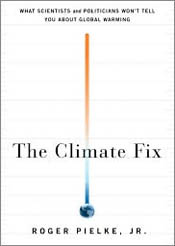The Climate Fix:
What Scientists and Politicians Won’t Tell You About Global Warming
Excerpt from Chapter One
In the summer of 1988, global warming first captured the imagination of the American public. In early June of that summer Senator Al Gore (D-TN) organized a congressional hearing to bring attention to the subject, one that he had been focusing on in Congress for more than a decade. The hearing that day was carefully stage-managed to present a bit of political theater, as was later explained by Senator Tim Wirth (D-CO), who served alongside Gore in the Senate and, like Gore, was also interested in the topic of global warming. “We called the Weather Bureau and found out what historically was the hottest day of the summer. Well, it was June 6th or June 9th or whatever it was. So we scheduled the hearing that day, and bingo, it was the hottest day on record in Washington, or close to it. What we did is that we went in the night before and opened all the windows, I will admit, right, so that the air conditioning wasn't working inside the room.”
The star witness that day was Dr. James Hansen, a NASA scientist who had been study climate since the 1960s. Hansen had decided that “it was time to stop waffling so much and say that the evidence is pretty strong that the greenhouse effect is here and is affecting our climate.” Hansen emphasized three points in his testimony: First, that “the earth is warmer in 1988 than at any time in the history of instrumental measurements;” second, “global warming is now large enough that we can ascribe with a high degree of confidence a cause and effect relationship” to the emission of greenhouse gases, primarily carbon dioxide; and third, the consequences are “already large enough to begin to affect the probability of extreme events such as summer heat waves.” The hearing’s public impact surely must have exceeded even its organizers expectations, as the temperature in the room and the scorching weather outside combined resulted in Hansen’s testimony receiving wide coverage in the national and international media.
Not long after the hearing, S. Fred Singer, who like James Hansen had spent much of his career as a government scientist and bureaucrat working on climate issues, published an op-ed on the pages of the Wall Street Journal critical of Hansen’s testimony and the reception that it had received. Singer, who had previously publicly questioned the science behind ozone depletion, acid rain and nuclear winter (and who would later question the science associated with smoking policies), asserted that “more research is needed” before any actions are taken to reduce greenhouse gas emissions due to the very large uncertainties that accompanied the issue. The public battle lines had been drawn on a debate that had been emerging in fits and starts for several decades, if not longer.
Looking back many years later one observer remarked that the 1988 Gore-Hansen hearing in the summer of 1988 “sparked front page coverage across the globe and touched off an unprecedented public relations war and media frenzy, marks the official beginning of the global warming policy debate.”5 Not only did the 1988 Gore-Hansen hearing mark a kind of kick-off of the public global warming debate in the United States, but it had all of the elements that would characterize that debate for the following decades: It had politicians seeking to stage manage the scientific community to support their political ambitions. Leading scientists willingly played along, enthusiastically lending the authority of science to the political campaign. Opponents of action agreed to engage the political battle through debates over science, primarily by raising uncertainty (or perhaps more accurately, by offering a set of competing certainties) as the basis for opposing efforts to regulate or otherwise address ever-increasing amounts of carbon dioxide and other greenhouse gases in the atmosphere. The global warming debate was underway, and how it started set the stage for how it would be fought for the next several decades.

